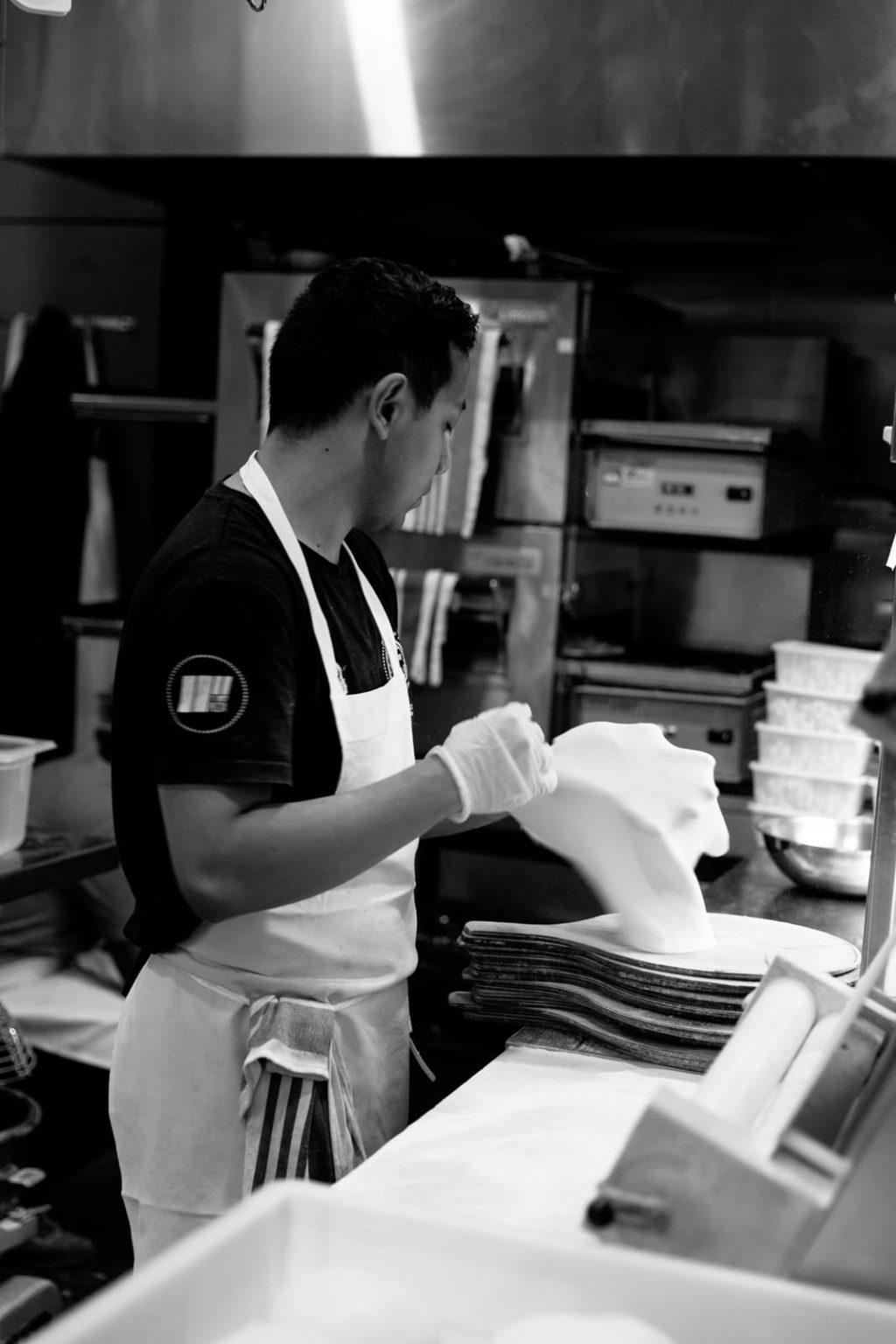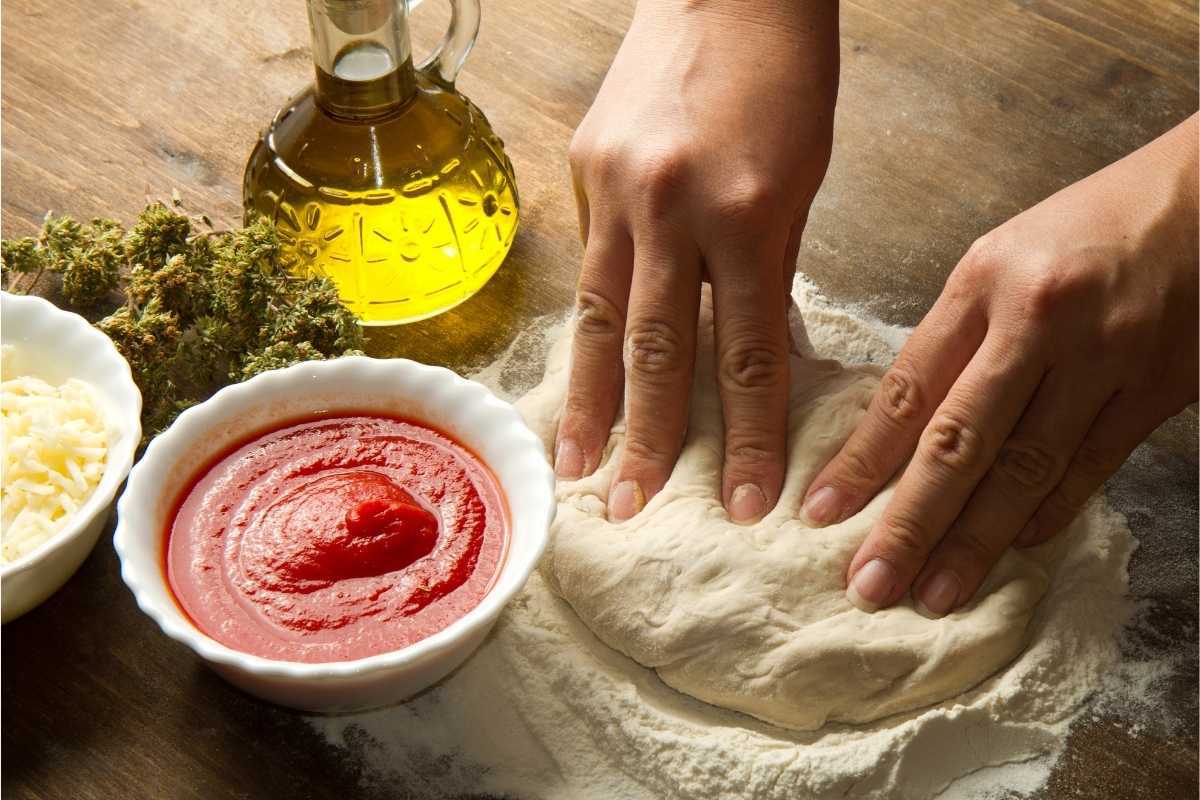
Why You Should Wait To Add Salt When Making Pizza Dough ForcellaEatery
Add the olive oil, salt, and flour. Beat on low speed for 2 minutes. Knead the dough: Keep the dough in the mixer and beat for an additional 5 full minutes, or knead by hand on a lightly floured surface for 5 full minutes. (If you're new to bread-baking, my How to Knead Dough video tutorial can help here.)

No Salt Pizza Dough Low Salt Kitchen
The amount of salt in pizza dough can vary based on the recipe, but a general guideline is about 1-2% of the weight of the flour used. For example, if you're using 500 grams of flour, you'd use about 5-10 grams of salt. This is approximately 1 to 2 teaspoons, as one teaspoon of table salt typically weighs around 5 grams.

Salt in Pizza Dough Explained — Ooni USA
Salt isn't just about adding a salty taste to your dough for the fun of it; it serves several critical functions in pizza: Flavour Enhancement Most obviously, salt is a flavour enhancer, in that it provides seasoning and boosts the flavour of foods it's added to, and this is no different with pizza.

Does Salt Kill Yeast in Pizza Dough?
Instructions. Dissolve the yeast in the water. Pour the water into the bowl of a stand mixer or a medium bowl. Sprinkle the yeast over the water, and let stand until the yeast has dissolved, about 5 minutes. Stir in the flour and salt to form a shaggy dough. Add the flour and salt.

The Effect of Salt in Pizza Dough Classroom Pizza YouTube
The main reason salt is so essential in Neapolitan pizza dough is that it facilitates a long, slow fermentation. At around 3% salt, it slows down the yeast and strengthens the gluten, which both help a long ferment. Salt also improves the flavor.

Anyonita Nibbles Gluten Free Recipes Failproof Gluten Free Pizza
Adding salt to pizza dough strengthens the gluten, which causes the dough to become stretchier. Therefore it's less sticky and easier to work with. Using salt will also slow the fermentation process, which means that the dough will taste better in the long run. Let's elaborate. Gluten is found in wheat flour.

Salt in Pizza Dough Explained — Ooni Australia
Let sit for 10 minutes. Add flour and salt. Once the yeast is bubbly, add 3 cups flour and 1 tablespoon salt. Using a dough hook, mix until the flour is incorporated. Add 1 1/2 cups flour and mix until the dough comes away from the sides of the bowl (it will still stick to the very bottom of the bowl).

Pizza Dough (Fresh) Crust Type Thin Crust, 8 oz Dough — Brava Brava
How to Make Pizza Dough: In a small bowl, stir together water, honey, and salt then sprinkle the top with 1/2 tsp yeast and let sit 5 minutes then stir. Measure 3 1/3 cups flour in a large mixing bowl and make a well in the center. Pour yeast mixture into the center then stir with a firm spatula until the dough comes together.

5 Ways to Take Your Pizza Dough to the Next Level
Preheat oven to 450 degrees F (230 degrees C), and lightly grease a pizza pan. Dotdash Meredith Food Studios. Place warm water in a bowl; add yeast and sugar. Mix and let stand until creamy, about 10 minutes. Dotdash Meredith Food Studios. Add flour, oil, and salt to the yeast mixture; beat until smooth.

Salt in Pizza Dough Explained — Ooni USA
Hand knead - 5 minutes. Standmixer - 3 minutes. Food processor - 40 seconds (yes, really!) Mix flour, yeast, salt and sugar, then mix in water and oil; It will come together into a rough dough that leaves the bowl pretty clean; Scrape out onto a floured work surface and bring it together into a ball; then.

Why My Pizza Dough Is Not Rising The Easy Solution Pizzeria Ortica
For Neapolitan-style pizza, Lewis recommends around 2.5 to 3% salt. For example, if you have 8 cups (1 kilogram) of flour, 2.5% of that will be 25 grams of salt. Tip: For help, check out the Ooni app, which features a Dough Calculator and takes the hassle out of calculating percentages! Lewis conducted an experiment to demonstrate the power and.

Salt in Pizza Dough The Secret to a Perfect Seasoned Crust
To Bake: Preheat oven to 450F. Divide dough into two even balls. (They should each weigh about 12-oz). Roll or press one ball of dough into a 12-inch pizza pan. (For a thick crust pizza, use all the dough for one 12-inch pizza. Press the dough up the sides of the pan to create a 1-inch edge.

CarmenChanCooks 2 ingredient pizza dough
2. Uncover the risen dough. 3. Divide the dough into about 8 pieces. 4. Pinch method to make a smooth dough ball (use "pinch and tuck" method in recipe steps. 5. Place the dived dough balls in airtight container for final rise (2 boxes with 4 dough balls in each).

What's The Effect of Adding Salt to Pizza Dough? Pizza Companion
First, grease the baking pan well. Both to prevent the pizza from sticking during baking and to give crispness to the underside. After that, take the dough and place it in the center of the baking pan. Step 9) - Now brush the surface of the dough with a tiny bit of oil and cover with plastic wrap.

Salt Why Is It Important? Salt Quantities in Pizza Dough Explained
Most recipes call for a level of salt between 1.7 and 2.1 percent of flour weight. This means that a typical pizza dough should contain about half a teaspoon or 2.3 grams of salt per cup of flour. There are two formulas for adjusting the salt level: one by weight and one by percentage.

Salt in Pizza Dough Explained — Ooni USA
Preheat the oven to about 400ºF. Turn the dough out of the bowl and place on a clean work surface. Gently press out the dough starting from the center of the pizza base and working out to the edge. If you like a soft and fluffy crust leave a ¼ inch around the edge of the pizza dough.